Milking is the process of extracting milk from the mammary glands of animals, usually dairy cattle, goats, or sheep. This procedure has been crucial for dairy production for ages and can be done in a variety of ways.
Table of Contents
There are two main methods: hand milking and machine milking, each with advantages and disadvantages depending on the context, scale, and efficiency necessary. Let’s look at both ways in detail:
1. Hand Milking
Hand milking is the traditional method of milking dairy cows in which the farmer or milkmaid extracts the milk manually with their hands. This strategy has been used for thousands of years and is still widespread in small-scale farming operations.
Process:
- The cow is initially secured, typically in a comfortable and hygienic environment.
- The udder is cleaned to prevent contamination.
- The farmer or milkmaid sits besides the cow and gently presses on the teats in a rhythmical motion, squeezing milk into a container.
- The milk is then filtered to remove contaminants and kept for future processing or consumption.
Advantages:
- Cost-effective: It requires minimal equipment, making it an economical option, particularly for small-scale farmers or those with just a few animals.
- Gentle on Animals: Skilled milkers can adjust their technique to ensure that the process is gentle and non-stressful for the animal.
- Low Maintenance: Since there are no machines involved, there is little need for mechanical maintenance or repairs.
- Flexibility: It can be done anywhere and does not depend on electricity or mechanical setups.
Disadvantages:
- Time-Consuming: It is a slow process, especially when milking a large herd. It requires significant time and labor.
- Labor-Intensive: It demands physical strength and endurance, as it can be tiring to milk by hand for long periods.
- Inconsistent Yield: The efficiency and amount of milk extracted can vary depending on the skill of the milker, which can lead to inconsistent results.
- Hygiene Concerns: There is a higher risk of contamination if proper hygiene practices are not followed. Exposure to the open air and direct handling may introduce bacteria into the milk.
2. Machine Milking
Machine milking is the modern method used in most commercial dairy farms. This method uses mechanical devices known as milking machines to automate the milking process. It is widely used because of its efficiency and capacity to handle huge dairy herds.
Process:
- The cow is placed in a stall, and the udder is cleansed to guarantee hygiene.
- The machine, which consists of a cluster of teat cups connected to a suction system, is used on the cow’s teats.
- The equipment creates a vacuum that replicates a calf’s sucking movement, collecting milk from the teats and transferring it to a sealed container or pipeline.
- Once the milking is over, the machine is removed and the equipment is cleaned for the next use.
Advantages:
- Efficiency: It allows farmers to milk multiple cows simultaneously, significantly reducing the time needed to milk large herds.
- Consistency: Machines provide uniform milking, ensuring that each cow is milked thoroughly and at the same rate each time, leading to higher and more consistent yields.
- Labor-Saving: With fewer manual steps involved, machine reduces the need for large amounts of labor, making it ideal for commercial operations.
- Improved Hygiene: The machines are designed to maintain high hygiene standards by minimizing direct contact with milk, reducing the risk of contamination.
- Monitoring and Data Collection: Advanced systems are equipped with sensors that can monitor milk yield, quality, and even health indicators for the cow, providing valuable data for dairy management.
Disadvantages:
- Initial Investment: The cost of purchasing and installing machines can be high, especially for smaller farms with limited capital.
- Maintenance: Machines require regular maintenance, including cleaning, repair, and replacement of parts, to ensure efficient operation and avoid breakdowns.
- Animal Stress: Poorly calibrated machines or improper use can lead to stress, discomfort, or even injuries in the animal, such as teat damage.
- Dependence on Technology: It depends on electricity and equipment functioning. Power outages or machine failures can disrupt the process.
Comparison:
| Feature | Hand Milking | Machine Milking |
|---|---|---|
| Speed | Slow, labor-intensive | Fast, milks multiple cows at once |
| Cost | Low initial cost | High initial investment |
| Labor | Requires manual labor | Reduces labor requirements |
| Hygiene | Higher risk of contamination | Better hygiene and sanitation |
| Scalability | Suitable for small-scale farms | Ideal for large-scale dairy operations |
| Consistency | Varies with skill | Provides consistent yields |
| Maintenance | Minimal | Requires regular maintenance |
| Animal Welfare | Can be gentler with experience | Needs careful calibration to avoid discomfort |
Conclusion
Both manual and machine milking have their uses in modern dairy farming, with hand better suited to small-scale, traditional, or subsistence farming and machine excelling in large-scale, commercial dairy operations. Each approach has advantages and disadvantages, and the choice is mostly determined by the farm’s size, available resources, and desired level of mechanisation.
Frequently Asked Questions
Which method is best for milking?
Always ensure that milking is performed with full hand method (Not with folded thumb), quickly, completely and comfortably (Animal should feel comfortable).
What are the two methods of milking?
Milking is done either by stripping or by the full-hand method.
Related Articles

